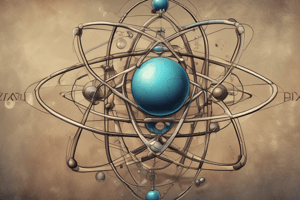Podcast
Questions and Answers
What did Thomson discover about the cathode rays in his experiment?
What did Thomson discover about the cathode rays in his experiment?
- They were a type of electromagnetic radiation.
- They were stationary in the tube.
- They were made of positive particles.
- They were made of very tiny, negative particles called electrons. (correct)
In Rutherford's experiment, what were the three observations he made?
In Rutherford's experiment, what were the three observations he made?
- The brightness of the beam, the speed of the particles, and their path. (correct)
- The size of the cathode ray particles, their negative charge, and their movement.
- The number of electrons in the beam, their speed, and their positive charge.
- The color of the beam, the shape of the tube, and the temperature of the room.
After Rutherford's experiment, what conclusions did he draw?
After Rutherford's experiment, what conclusions did he draw?
- Atoms have a dense, positively charged center called a nucleus. (correct)
- Electrons are stationary particles within the atom.
- Atoms are solid spheres with no internal structure.
- Electrons are larger than protons and neutrons.
Which scientist conducted an experiment with a cathode ray and discovered electrons?
Which scientist conducted an experiment with a cathode ray and discovered electrons?
What type of view in Rutherford's experiment allowed him to make conclusions about atoms?
What type of view in Rutherford's experiment allowed him to make conclusions about atoms?
According to Dalton's atomic theory, atoms are:
According to Dalton's atomic theory, atoms are:
In Thomson's model of the atom, atoms contained:
In Thomson's model of the atom, atoms contained:
According to the Bohr Planetary Model, electrons:
According to the Bohr Planetary Model, electrons:
Which scientist proposed the idea that the centre of the atom has a positive charge?
Which scientist proposed the idea that the centre of the atom has a positive charge?
In the nuclear model proposed by Rutherford, the majority of the atom is made up of:
In the nuclear model proposed by Rutherford, the majority of the atom is made up of:
Chadwick discovered that the nucleus of an atom contains protons and:
Chadwick discovered that the nucleus of an atom contains protons and:
Flashcards are hidden until you start studying
Study Notes
Thomson's Discoveries
- Discovered that cathode rays are streams of negatively charged particles, later named electrons.
- Demonstrated that cathode rays could be deflected by electric and magnetic fields, indicating their charge.
Rutherford's Experiment Observations
- Most alpha particles passed through the gold foil without deflection, suggesting a lot of empty space in atoms.
- A small fraction of alpha particles were deflected at large angles, indicating the presence of a dense core.
- A very few alpha particles were reflected back toward the source, revealing that the nucleus is positively charged.
Rutherford's Conclusions
- Proposed that atoms consist of a small, dense positively charged nucleus surrounded by electrons.
- Introduced the idea of the nuclear model of the atom, shifting away from previous models based on uniform density.
Discovery of Electrons
- J.J. Thomson conducted experiments using cathode rays to discover the existence of electrons.
Rutherford's View on Atoms
- Utilized a scattering experiment design, allowing for direct observation of interactions between alpha particles and atomic structure.
Dalton's Atomic Theory
- Atoms are indivisible and indestructible particles, which combine in whole-number ratios to form compounds.
- All atoms of a given element are identical in mass and properties.
Thomson's Atomic Model
- Proposed the "plum pudding" model, where atoms contain electrons embedded in a positively charged "soup."
Bohr Planetary Model
- Electrons orbit the nucleus in defined energy levels, and can jump between levels when absorbing or emitting energy.
Positive Charge in Atoms
- Ernest Rutherford proposed that the center of the atom contains positive charge, known as the nucleus.
Rutherford's Nuclear Model
- The majority of the atom is empty space, with a small, dense nucleus at the center comprising protons and neutrons.
Chadwick's Discovery
- Discovered that the nucleus also contains neutrons, which are neutral particles that contribute to the mass of the atom.
Studying That Suits You
Use AI to generate personalized quizzes and flashcards to suit your learning preferences.




